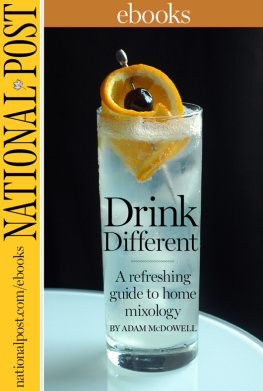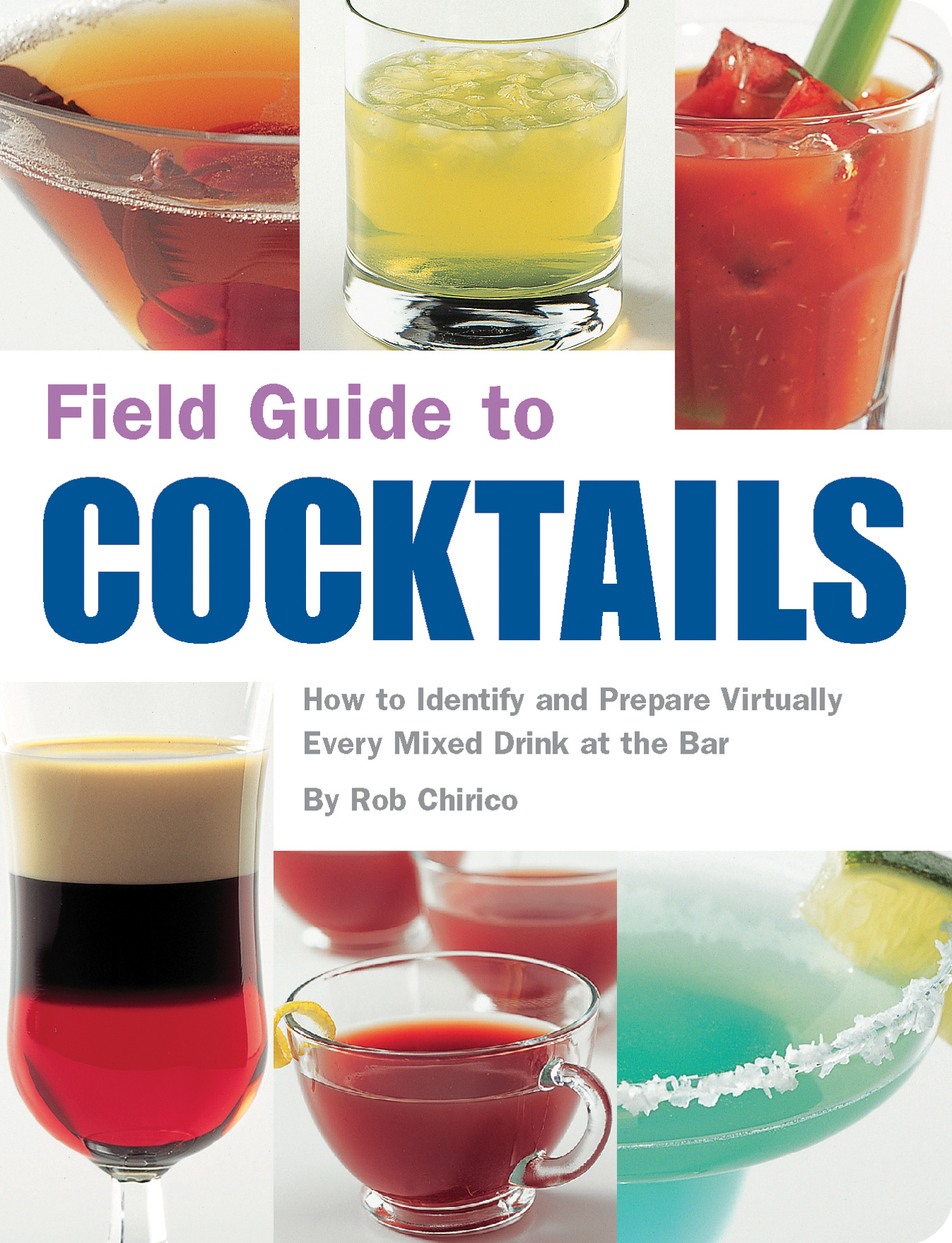DISCLAIMER
This volume attempts to be as comprehensive as possible, but new cocktails seem to be created every minute, and one could fill a worthy tome with just the names of the new Martinis being concocted alone. The major entries in this guide are a jumping-off point for understanding the fundamentals of mixing each recipe, and the accompanying variations are examples and samples of each cocktails possibilities.
Copyright 2005 by Quirk Productions, Inc.
All rights reserved. No part of this book may be reproduced in any form without written permission from the publisher.
Library of Congress Cataloging in Publication Number: 2005921505
eBook ISBN: 978-1-59474-841-7
Trade Paperback ISBN: 978-1-59474-063-3
Designed by Karen Onorato
Edited by Erin Slonaker
Photography by Steve Legato
Iconography by Karen Onorato
All photographs copyright 2005 by Quirk Productions, Inc.
Quirk Books
215 Church Street
Philadelphia, PA 19106
quirkbooks.com
v3.1
Introduction
It was not so long ago that the search for a classic cocktail glass, the ubiquitous Martini glass, would often turn up dry. In 1973 in Esquire , James Villas proclaimed, Young people do not like martinis, and theyre not drinking them. Ever! Anywhere! The Martini, however, is alive and flourishingas are countless other cocktails. From old favorites like the Old Fashioned that were sipped by our grandparents to new trendsetters like the Cosmopolitan, cocktails are joyously being discovered and rediscovered everywhere. Selecting the right cocktail from the array of potables being shaken and stirred can be overwhelming. The purpose of this easy-to-carry guide is to familiarize the reader with classic cocktails, their contemporary progeny, and some drinks that were once the rage but are now all but forgotten. As a practical reference, it is designed for the reader eager to know what to look for in an authentic Daiquiri as well as for the aspiring home bartender who wants to master muddling and mixing a Brazilian Caipirinha.
Each entry includes recipes, some historical or anecdotal background, and purchasing information. Youll learn what rye whiskey is and why it should be used in a Manhattan, how to layer drinks, where not to order a Margarita, and how to modify your cocktails to suit your taste and that of your guests. Every recipe also includes a helpful section on food pairingsan area almost patently neglected in most cocktail books.
In this age of automated supermarket checkouts, cash machines, and self-serve gasoline pumps, the cocktail, too, is often in jeopardy of being mass-produced and premixed, but armed with this guide you can keep the art of mixology alive. Among the many stalwart bartenders who are proponents of true mixology, New York barmen Dale DeGroff and Gary Regan are the leaders in their field, and readers will come upon their names throughout this book.
Before we begin, let us briefly explore what a cocktail is and where it comes from. This would be a simple matter if we knew its originbut we dont. Naturally, speculation abounds. The word cocktail has been linked to a seventeenth-century British concoction of chicken broth and ale called cock ale; to the French coquetel , from coquetier , for the egg cups in which Antoine Peychaud served brandy and bitters (see ); and to the dregs at the bottom of barrels called cock-tailings. Although its origin is elusive, the word cocktail was in general use by the early 1800s. In its unadorned state, the cocktail is a mixture of two or more ingredients. Embellished, the cocktail is the soul of conviviality and a prelude to adventure. The situations and times to order or mix cocktails are endless, but there is probably nothing more therapeutic than sitting down with friends or a loved one after an arduous day for the venerable cocktail hour.
Behind BarsAn Insiders Look at Ordering Out
The recipes in this guideand practically all cocktail bookshave been formulated to make a small number of drinks at a time. Most bars and bartenders do not have the luxury of precisely measuring out drinks. With one eye on their time and the other trained on managements expenses, bartenders generally standardize amounts out of necessity as well as for consistency. In fact, most standard mixed drinks contain 3 ounces of liquid; a Martini, for example, will have 3 ounces of straight alcohol, while a gin and tonic on the rocks will have 1 ounce gin and 2 ounces tonic. A bar shot glass, however big or heavy, typically contains just 1 ounce, and many bars require measured 1-ounce drink pourers on bottles. Think of that next time you order three shots of Stoli when you could have ordered a bone-dry (i.e., no vermouth) Stoli Martini at less than half the price. I have seen savvy customers order bone-dry Jgermeister Martinis to the same end. Here are a few other tips from behind the bar:
Spirits fall into three categories: well or rail (generic), call (name brand), and top-shelf (costly name brand). Know what you want and be specific when you orderotherwise, you will be given well, which is usually not very good.
Dont assume. If you want a Gin Martini, ask for oneand, again, preferably by brand. Dont be surprised if, when you ask for a Martini, you receive a Vodka Martini on the rocks with a twist instead of the anticipated straight-up Gin Martini with olives. The same goes for Alexanders, Stingers, and any number of other drinks.
Many bars will supersize drinks like a Margarita for an additional fee, but be aware that usually little or no alcohol is added to the extra ice and mix.
Dont be afraid to try a new drink the bartender recommends. It often leads to an earlier buyback, or a drink on the house.
Bartenders are responsible for your safety and the safety of others. They have every right not to serve you if they think you are in the redthat you have had too much to drinkand they are required to call the police if you leave and choose to drive while intoxicated.
If you really want to alienate your bartender, try clapping your hands or snapping your fingers to get attention.
Bartenders are not out to cheat you; they depend on your tips. If you think the drinks are too small, the management is probably responsible. Dont take it out on the bartender.
A Note on the Headings
The drinks presented here are primary cocktails, and most include cocktails with similar ingredients or themes. The mere fact that you can replicate any recipe precludes extinction; however, there are drinks on the endangered species listdrinks that have had their heyday but are now rarely, if ever, served. These are denoted by the following icon:  . Each entry is accompanied by a heading that provides a general description of the cocktail, including what is known of its history, the origin of its name, and its creator. Purchase refers to the best places to buy these cocktails as well as when they should be practiced by the home bartender. The ideal times and places to sip your cocktails are discussed under Areas and Time of Occurrence, and the appropriate months of the year to have them are briefly noted in Season. Preparation enumerates ways to make the cocktail, along with methods of serving and any pertinent information particular to that cocktail.
. Each entry is accompanied by a heading that provides a general description of the cocktail, including what is known of its history, the origin of its name, and its creator. Purchase refers to the best places to buy these cocktails as well as when they should be practiced by the home bartender. The ideal times and places to sip your cocktails are discussed under Areas and Time of Occurrence, and the appropriate months of the year to have them are briefly noted in Season. Preparation enumerates ways to make the cocktail, along with methods of serving and any pertinent information particular to that cocktail.






 . Each entry is accompanied by a heading that provides a general description of the cocktail, including what is known of its history, the origin of its name, and its creator. Purchase refers to the best places to buy these cocktails as well as when they should be practiced by the home bartender. The ideal times and places to sip your cocktails are discussed under Areas and Time of Occurrence, and the appropriate months of the year to have them are briefly noted in Season. Preparation enumerates ways to make the cocktail, along with methods of serving and any pertinent information particular to that cocktail.
. Each entry is accompanied by a heading that provides a general description of the cocktail, including what is known of its history, the origin of its name, and its creator. Purchase refers to the best places to buy these cocktails as well as when they should be practiced by the home bartender. The ideal times and places to sip your cocktails are discussed under Areas and Time of Occurrence, and the appropriate months of the year to have them are briefly noted in Season. Preparation enumerates ways to make the cocktail, along with methods of serving and any pertinent information particular to that cocktail.